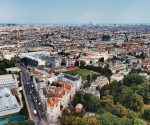I visited a UK seaside town with independent shops – 1 thing surprised me | UK | Travel
There’s always something special about hopping on a train in London and getting off somewhere by the sea. The first time I did this was when I went to Brighton to treat myself after finishing university. But days when a trip to Brighton promised peace and tranquil seaside moments are long gone. I was seeking calm and opted for a similarly accessible trip south-east of the capital. Paying under £30 for a return ticket, my friends and I set off to Kent, visiting the hip town of Margate.
The Labour stronghold has long attracted Londoners looking to escape the city for a seaside town that is still culturally vibrant yet cheaper than Brighton. On Rightmove, a studio to rent in Brighton nears £2,000, while in Margate the average price is around £1,000. Part of the reason lies in the 1970s, when Margate fell into steep economic decline as Brits swapped traditional seaside holidays for cheap package deals abroad. Many houses were left empty and property prices fell, although the recent influx of young urbanites pushed costs up.
Walking from the train station to the town centre, we passed by a row of amusement arcades, a nostalgic but somewhat melancholic hallmark of many British coastal towns that once provided affordable fun for holidaymakers. Margate is also home to Dreamland, an iconic theme park featuring the UK’s oldest roller coaster, which opened in 1920.
For a small seaside town, it has a buzzing, decidedly creative atmosphere with excellent places to eat and drink. Our first stop was the Curve Coffee Store, a hip coffee house with an all-day menu. We then took it to Walpole Bay, a local beach that’s significantly less crowded than Margate Main Sands and features the UK’s largest tidal swimming pool. In the distance, we could see beautiful coastal cliffs stretching all the way to the popular Botany Bay in Broadstairs, just under three miles away.
We then strolled through Margate’s independent shops, from a local Polish grocery with hidden gems of Central and Eastern Europe, to an organic store flooded with affluent hipsters and a cosy vinyl shop. Meanwhile, our local friend was stopped by passers-by for a catch-up at least five times. A delightful small-town bliss that feels all the more welcome when living in the anonymous capital.
It was here that I realised what struck me most about Margate: its strong community spirit. With a population of around 60,000, the town is renowned for its close-knit feel and welcoming vibe. This is perhaps driven by the growing number of people moving from London in search of exactly that — a quieter pace of life and a greater sense of belonging.
We also stopped to see a free exhibition at the Turner Contemporary gallery. The modern art gallery was opened in 2011 at £17.5m and is often tied to the town’s revival. Despite bringing investment, the institution has faced criticism from artists and some councillors for being elitist and failing to support the local art scene. Recently, activists criticised the gallery for not publicly speaking up against war crimes in Gaza despite its past support for socially and politically engaged art.
We couldn’t resist ending the trip with dinner at the famous chippy Peter’s Fish Factory, though the taste fell a little short of our expectations — not helped by a seagull attacking our food mid-meal. The final stop was the Xylo Brewery, where we contemplated life and enjoyed the last of the seaside views before catching the hour-and-a-half train back to King’s Cross.










